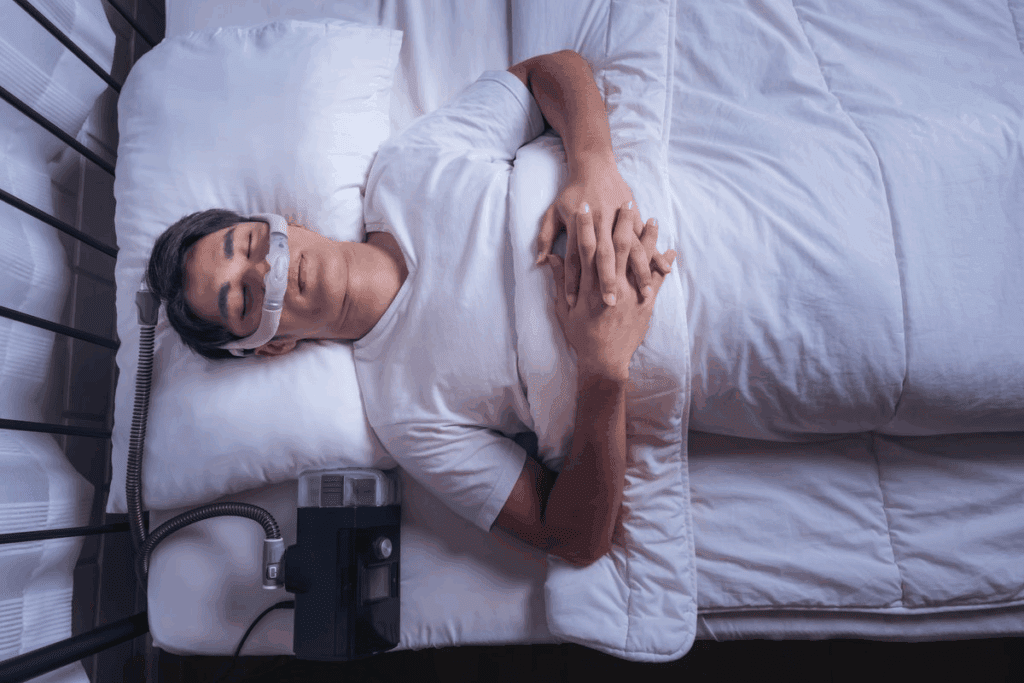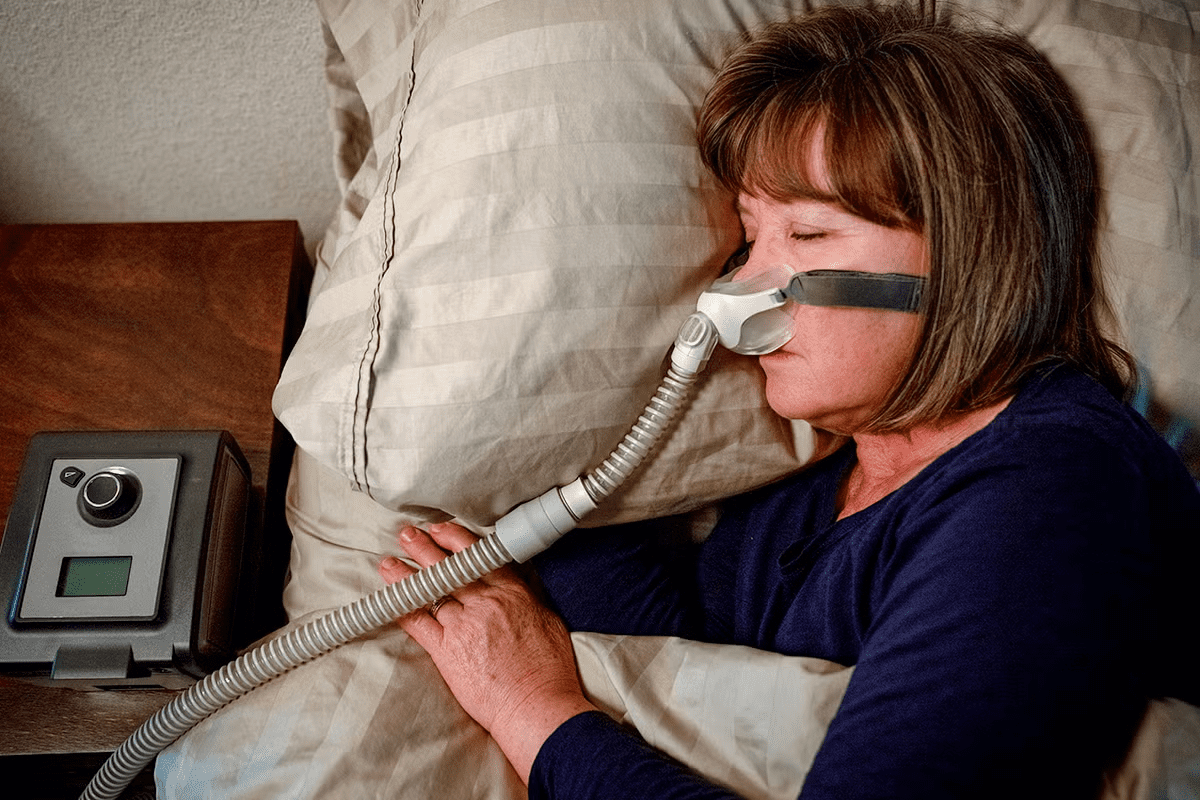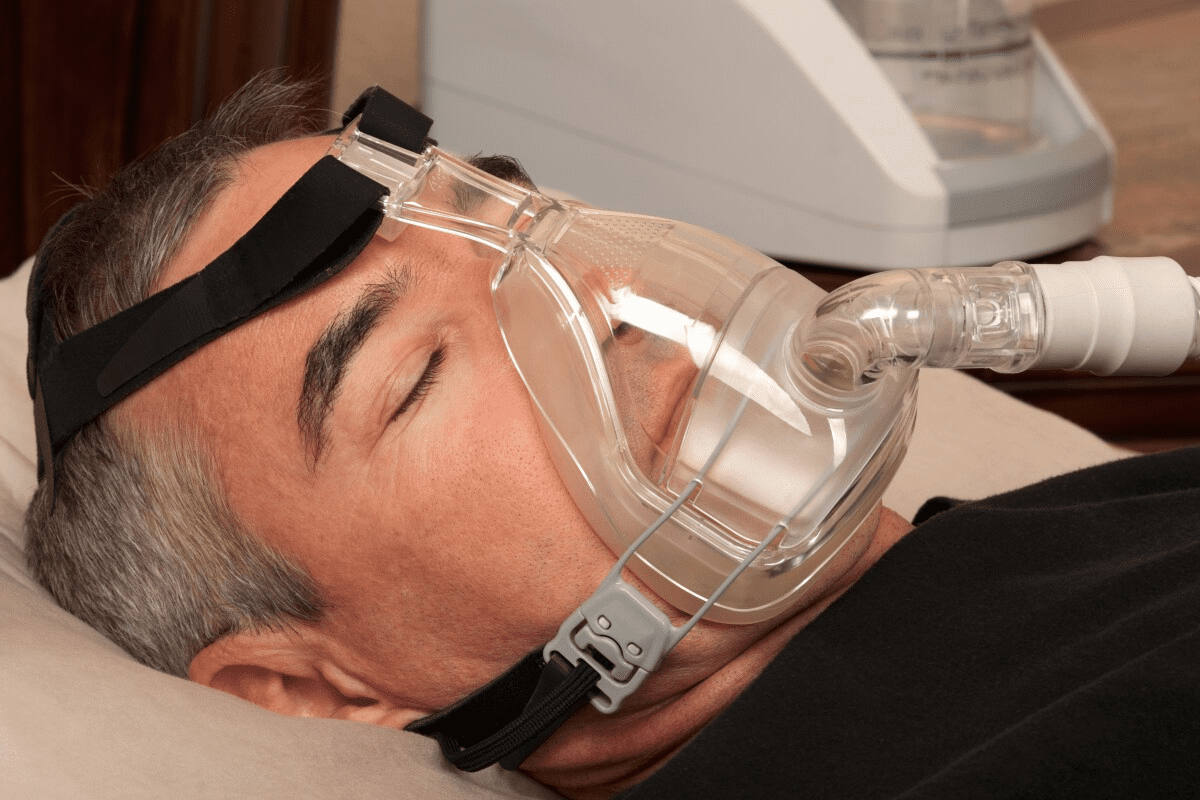Last Updated on October 31, 2025 by Saadet Demir

Sleep apnea is a big problem worldwide, affecting millions. About 425 million adults have moderate-to-severe obstructive sleep apnea (OSA). Traditional CPAP therapy works for some but has big downsides. It can be uncomfortable, hard to wear, and not very convenient, leading to many people not sticking with it.
New alternatives are emerging, giving hope to those who can’t handle traditional treatments. At Liv Hospital, we’re all about finding new ways to help. That’s why we’re excited about hypoglossal nerve stimulation devices. They’re comfortable and really work well.
The latest treatments, like implantable devices, are changing how we treat sleep apnea. These new options give patients more choices and help them live better lives.
The 5 best implantable device for sleep apnea options, offering an effective solution for CPAP-intolerant patients.

Sleep apnea is becoming a big problem worldwide. It’s a serious sleep disorder where breathing stops or gets shallow during sleep. Obstructive Sleep Apnea (OSA) is the most common, caused by the throat muscles relaxing and blocking the airway.
Living with sleep apnea can really affect your life. Finding sleep apnea treatment near me is key to managing it. But, many cases are not found.
OSA happens when the throat muscles relax and block the airway during sleep. This can lower blood oxygen levels, mess up sleep, and lead to health problems. Symptoms include loud snoring, morning headaches, and feeling very tired during the day.
“Sleep apnea is a major risk factor for cardiovascular disease, and it’s estimated that untreated sleep apnea can increase the risk of heart failure by up to 300%.”
About 425 million adults worldwide have moderate to severe OSA. In the U.S., around 30 million have OSA, but only 6 million are diagnosed. This shows we need more awareness and sleep apnea treatment without CPAP.
Region | Estimated OSA Cases | Diagnosed Cases |
North America | 30 million | 6 million |
Europe | 25 million | 4 million |
Asia | 200 million | 2 million |
These numbers show we need to find best alternatives to CPAP for treating sleep apnea. As we deal with sleep apnea, we must look at new ways to help patients.

The gap in diagnosing sleep apnea is a big problem. It means millions of people don’t get the care they need. Even though more people know about sleep apnea, many cases are missed or wrongly diagnosed.
Obstructive Sleep Apnea (OSA) affects about 30 million adults in the U.S. But only 6 million have been diagnosed. This gap is due to lack of awareness, poor screening, and the condition’s complexity.
Getting a proper diagnosis is key. Untreated sleep apnea can cause serious health issues. These include heart disease, high blood pressure, diabetes, and mental health concerns.
Not treating sleep apnea can have big effects on a person’s life. Some of these effects are:
The table below shows the bad effects of not treating sleep apnea. It also shows the good effects of proper treatment:
Condition | Untreated Sleep Apnea | With Proper Treatment |
Cardiovascular Disease | High Risk | Reduced Risk |
Daytime Fatigue | Severe | Improved Energy |
Mood Disorders | Increased Risk | Reduced Symptoms |
Understanding the gap in diagnosing sleep apnea and its effects helps us. We can work to improve diagnosis rates. This includes using new sleep apnea solutions and best apnea devices, like apap for sleep apnea.
CPAP therapy is a common treatment for sleep apnea. But, it faces big challenges in getting patients to stick with it. The discomfort and hassle of using a CPAP machine often lead to patients giving up on it.
Research shows that almost half of patients stop using CPAP therapy. The main reasons are discomfort with the mask, the pressure, and the hassle of traveling with it.
These issues can really affect a person’s life. The mask can irritate the skin and make people feel trapped. The machine’s noise can bother both the user and their partner.
Here are the common complaints about CPAP therapy:
Complaint | Description | Impact on Patient |
Discomfort | The CPAP mask can cause skin irritation and discomfort. | Leads to poor sleep quality and daytime fatigue. |
Claustrophobia | The mask can induce feelings of claustrophobia. | Causes anxiety and stress, making it hard to fall asleep. |
Inconvenience | Traveling with the CPAP machine can be cumbersome. | Restricts travel and social activities. |
These problems show we need better treatments for sleep apnea. New medical tech has brought solutions like implantable devices. They are more comfortable and easy to use than CPAP therapy.
Looking into these new options can help improve life for those with sleep apnea.
Implantable devices are changing the game for sleep apnea treatment. They offer hope to millions worldwide. These devices tackle the root cause of sleep apnea, providing a better solution than old treatments.
Thanks to new neurostimulation tech, sleep apnea management is getting a big boost. This tech uses an implant to keep the airway open during sleep. This stops apneic events.
Neurostimulation targets the hypoglossal nerve, which controls the tongue and throat muscles. It keeps the airway open, stopping sleep apnea.
The Inspire Upper Airway Stimulation system is a top example. It’s a small implant that’s easy to put in. Patients control it with a remote, turning it on and off as needed.
Unlike CPAP therapy, which just manages symptoms, implantable devices like Inspire tackle the cause. They directly stimulate the airway nerves, keeping it open during sleep.
Treatment Aspect | CPAP Therapy | Implantable Devices |
Treatment Approach | Symptom Management | Root Cause Treatment |
Patient Compliance | Often challenging due to discomfort and inconvenience | Generally higher due to minimal invasiveness and ease of use |
Effectiveness | Variable, dependent on patient compliance | High, with significant reduction in apneic events |
Implantable devices directly tackle sleep apnea’s cause, making them a great alternative to traditional treatments. As tech advances, we’ll see even more innovative sleep apnea treatments.
The Inspire Upper Airway Stimulation System is a big step forward in treating sleep apnea. It uses a small implant to control tongue movements. This keeps the airway open while you sleep.
Developed by Inspire Medical Systems, the Inspire system was a first in using hypoglossal nerve stimulation. It tackles the main cause of obstructive sleep apnea. This ensures the airway stays open, cutting down on apnea events.
Key Features of the Inspire Upper Airway Stimulation System:
We will look at the system’s benefits and clinical outcomes in more detail below.
Studies have shown the Inspire Upper Airway Stimulation System works well. Patients see better sleep quality and less sleep apnea.
Clinical Outcomes | Pre-Treatment | Post-Treatment |
Apnea-Hypopnea Index (AHI) | 32.5 ± 15.6 | 9.4 ± 11.4 |
Oxygen Desaturation Index (ODI) | 28.9 ± 16.2 | 7.4 ± 10.3 |
Epworth Sleepiness Scale (ESS) | 11.6 ± 5.4 | 6.8 ± 4.7 |
The Inspire Upper Airway Stimulation System is a major leap in sleep apnea treatment. It offers a new, effective option for those tired of CPAP therapy.
The Nyxoah Genio System is changing how we treat sleep apnea. It uses new technology to help patients sleep better. This device is a big step forward for those with sleep apnea.
This system is unique in treating sleep apnea. It works by stimulating both sides of the hypoglossal nerve. This is different from older methods that only work on one side.
The Nyxoah Genio System’s technology is a big change in sleep apnea treatment. It helps manage the upper airway better. This could lead to better results for patients.
Some key benefits of the Nyxoah Genio System are:
Studies show that this technology can improve sleep quality. It also reduces apnea events in patients with moderate to severe sleep apnea.
Feature | Nyxoah Genio System | Traditional CPAP |
Stimulation Method | Bilateral Hypoglossal Nerve Stimulation | Continuous Air Pressure |
Invasiveness | Minimally Invasive Implant | Non-Invasive Mask |
Patient Compliance | High | Variable, often lower |
“The Nyxoah Genio System represents a significant advancement in our ability to treat sleep apnea effectively. Its bilateral stimulation approach offers new hope for patients who have struggled with traditional treatments.”
Innovative solutions like the Nyxoah Genio System are changing sleep apnea treatment. They offer better and more patient-friendly options. This device is a promising development in the field.
The LivaNova Aura6000 is a new way to manage sleep apnea. It’s a next-generation device that doesn’t need CPAP machines. This makes it a more comfortable and easy option for patients.
This system is made to fix the problems of old sleep apnea treatments. It uses advanced technology to help you sleep better and longer.
The Aura6000 is a big step forward in treating sleep apnea. This newest treatment for sleep apnea is both effective and easy to use. It’s designed to be less invasive and less painful than old machines.
Here are some benefits of the LivaNova Aura6000:
The LivaNova Aura6000 gives patients a new hope. It’s a sleep apnea treatment without CPAP. Its design and technology make it a great choice for those looking for a comfortable solution.
For those looking for best alternatives to CPAP, the Resonetics Apnex Medical HGNS System is worth checking out. It uses Hypoglossal Nerve Stimulation (HGNS) to treat obstructive sleep apnea (OSA).
This device is made to overcome CPAP therapy’s drawbacks. It’s more comfortable and easy to use. It works by stimulating the hypoglossal nerve to keep the airway open, lessening sleep apnea episodes.
The HGNS technology in the Resonetics Apnex Medical HGNS System uses targeted muscle stimulation. It makes sure the right muscles are stimulated to keep the airway open. This reduces sleep apnea symptoms.
As a new sleep apnea device, it’s getting a lot of attention for its success. Studies show HGNS therapy improves sleep quality and cuts down on apneic events.
“The use of HGNS technology represents a significant advancement in the treatment of sleep apnea, providing a more tolerable and effective alternative to traditional therapies.”
Expert Opinion
When looking at sleep apnea treatments, it’s key to weigh the pros and cons of each. The Resonetics Apnex Medical HGNS System is a good choice for those exploring APAP for sleep apnea alternatives or other options.
In summary, the Resonetics Apnex Medical HGNS System is a great addition to sleep apnea treatments. Its innovative technology and focused approach make it appealing to both patients and healthcare providers.
ImThera Medical has created the aura6000 THN Sleep Therapy system. It uses a multi-point contact stimulation approach to treat sleep apnea. This implantable device for sleep apnea aims to better stimulate the hypoglossal nerve, improving treatment results.
The aura6000 THN Sleep Therapy system is a newest treatment for sleep apnea. It offers hope to those who haven’t found relief with other treatments. By stimulating the hypoglossal nerve, it helps keep the airway open, reducing apneic events.
The aura6000 THN uses a multi-point contact stimulation approach. This method allows for more precise and effective stimulation. It helps control the tongue and other airway muscles, reducing sleep apnea symptoms.
Users of this snore tool and sleep apnea treatment have seen big improvements. They report better quality of life. The system’s ability to reduce apneic events and improve sleep quality makes it a valuable option.
As we look for new solutions for sleep apnea, the aura6000 THN stands out. Its unique technology and effective treatment outcomes make it a key option for patients and healthcare providers.
Studies show that implantable devices are effective in treating sleep apnea. These devices offer a new way to manage the condition, aside from CPAP therapy. They have been shown to improve symptoms in many patients.
Clinical trials have found that most patients see big improvements. About three out of four patients notice a big drop in apnea symptoms. This is thanks to the advanced technology of these devices.
The best apnea devices not only cut down on apnea episodes but also boost sleep quality. This is great for those who have had trouble with CPAP therapy. It offers a more comfortable and effective way to treat sleep apnea.
Long-term studies back up the success of these devices. Patients using them see lasting improvements and better quality of life. Not needing CPAP has been a big plus for many, making sleep more comfortable.
These devices also help with overall health. They reduce daytime tiredness, improve thinking skills, and help the heart. As we move forward, implantable devices will be key in finding new sleep apnea solutions.
Choosing the right treatment for sleep apnea is important. It involves understanding who can get implantable devices and dealing with insurance. These devices are good alternatives to CPAP therapy but have their own criteria.
To see if you’re a good fit for these devices, several things are checked. These include how bad your sleep apnea is, your body mass index (BMI), what treatments you’ve tried before, and your overall health. Here’s what we look at:
Healthcare providers do detailed checks to see if these treatments are right for you. This includes sleep studies and medical checks. It makes sure the treatment is safe and works well.
Knowing about insurance and costs is key to getting these devices. Insurance plans are different, and what’s covered can vary a lot.
Insurance Factor | Description | Typical Coverage |
Pre-Approval | Prior authorization required before treatment | Often required |
Device Coverage | Coverage for the implantable device itself | Partial to full coverage |
Procedure Costs | Costs associated with the implantation procedure | Partial coverage |
Follow-Up Care | Coverage for post-procedure follow-up and adjustments | Partial coverage |
It’s important to talk to your healthcare team and insurance about these devices. We suggest discussing:
Knowing these details helps you make the best choice for your treatment. It also makes dealing with insurance easier.
Exploring the latest in sleep apnea treatments shows promising new options. Devices like the Inspire Upper Airway Stimulation System and others are changing how we manage sleep apnea. They offer alternatives to traditional CPAP therapy.
When picking a sleep apnea treatment, think about what you need and the latest tech. There are many implantable devices to choose from. This means patients can find a solution that fits their life and health needs.
It’s important for those with sleep apnea to stay up-to-date on new treatments. This knowledge helps patients make informed choices about their care. The future of sleep apnea treatment looks bright, with ongoing innovation.
We suggest looking into implantable devices like the Inspire Upper Airway Stimulation System. Also, consider the Nyxoah Genio System, LivaNova Aura6000 Sleep Therapy System, and others. These have shown great promise in treating sleep apnea.
These devices use neurostimulation to keep the airway open. This prevents the blockage that causes sleep apnea.
The Inspire Upper Airway Stimulation System is a new treatment for sleep apnea. It uses hypoglossal nerve stimulation to keep the airway open during sleep.
Yes, new devices like the Nyxoah Genio System and LivaNova Aura6000 Sleep Therapy System are available. They offer new technologies and better results.
To find out if you’re a candidate, you’ll need a sleep study and a consultation with a healthcare professional. They will assess your sleep apnea and overall health.
Insurance coverage varies. It depends on your provider and policy. Check with your insurance to see what’s covered.
An APAP machine adjusts pressure automatically. This makes it more comfortable and effective for treating sleep apnea.
Snore tools can reduce snoring, but they’re not a cure for sleep apnea. Always talk to a healthcare professional for the right treatment.
The latest treatments include implantable devices like the Inspire Upper Airway Stimulation System. These offer better outcomes and improve your quality of life.
Search online or ask your insurance for treatment centers and healthcare professionals near you.
National Center for Biotechnology Information. (2025). 5 Best Implantable Devices for Sleep Apnea Top. Retrieved from https://pmc.ncbi.nlm.nih.gov/articles/PMC4576333/
Subscribe to our e-newsletter to stay informed about the latest innovations in the world of health and exclusive offers!
WhatsApp us